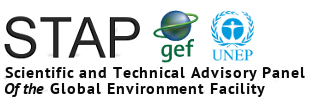In advance of the 50th Council Meeting of the Global Environment Facility (GEF), the Scientific and Technical Advisory Panel (STAP) of the GEF has released four reports addressing the design of sustainable development projects; sustainable land management (SLM) and food security; indicators for assessing the sustainability of agricultural production; and a framework for managing flows in the source-to-sea continuum.
 June 2016: As input to the 50th meeting of the Council of the Global Environment Facility (GEF), the Scientific and Technical Advisory Panel (STAP) of the GEF produced four reports, addressing: the design of sustainable development projects; sustainable land management (SLM) and food security; indicators for assessing the sustainability of agricultural production; and a framework for managing flows in the source-to-sea continuum.
June 2016: As input to the 50th meeting of the Council of the Global Environment Facility (GEF), the Scientific and Technical Advisory Panel (STAP) of the GEF produced four reports, addressing: the design of sustainable development projects; sustainable land management (SLM) and food security; indicators for assessing the sustainability of agricultural production; and a framework for managing flows in the source-to-sea continuum.
The 50th meeting of the GEF Council is taking place from 7-9 June 2016, at World Bank headquarters in Washington DC, US.
The report, titled ‘Designing Projects in a Rapidly Changing World: Guidelines for Embedding Resilience, Adaptation and Transformation into Sustainable Development Projects,’ defines the concepts of resilience, adaptation and transformation, and discusses how they can be built into projects to enable them to account for large-scale, unpredictable external changes or shocks, and still deliver on their intended outcomes. The publication offers key components for project design based on the Resilience, Adaptation Pathways and Transformation Assessment (RAPTA) Framework.
‘Sustainable Land Management and its Relationship to Global Environmental Benefits and Food Security’ provides a synthesis of current knowledge on SLM and its relationship to combating land degradation, enhancing food security, and addressing climate change adaptation and mitigation. The paper discusses the possibility of developing indicators and metrics for assessing land and monitoring the effectiveness of SLM programmes. It highlights the global environmental benefits of addressing land degradation and makes recommendations for investing in SLM, noting that the process of prioritizing SLM investment strategies should consider immediate and achievable targets.
The paper, ‘A Review of Indicators Used to Assess the Sustainability of Commodity Agricultural Production,’ underpins STAP’s work on the development and selection of indicators for the Integrated Approach Pilot (IAP) on ‘Taking Deforestation out of Commodity Supply Chains,’ which aims to “reduce the global impacts of agricultural commodities on climate change and biodiversity by meeting the growing supply and demand of palm oil, soybean and beef through means that do not lead to deforestation.” The paper discusses the difficulties of selecting indicators and highlights the lack of consensus among scholars and the policy community on which indicators to employ. It concludes by proposing a list of 12 core production facets of sustainable commodity agriculture that are cost-effective and comparable across countries and commodities, and can comprise a minimum list of practical measures for tracking progress towards the overall IAP programme objective.
‘A Conceptual Framework for Governing and Managing Key Flows in a Source-to-Sea Continuum’ aims to present foundations for the integration of “blue” and “green” economic growth opportunities in the source-to-sea continuum. The paper defines the continuum and discusses key biophysical flows and linkages across open oceans, adjoining seas, estuaries, coastal areas, freshwater systems and land or terrestrial systems. It discusses how the GEF portfolios address these linkages and reviews case studies of source to sea initiatives in order to draw out key factors that can be used to build sustainability into GEF projects. The paper then presents seven recommendations to identify opportunities with regard to growing investments that address source-to-sea priorities throughout the GEF portfolio. These include: understanding governance dimensions of source-to-sea systems; engaging key stakeholders and ministries; giving systematic consideration to source-to-sea systems in transboundary diagnostic analysis/strategic action programmes; capitalizing on existing thematic and geographic linkages between GEF focal areas; applying a coherent theory of change; developing an IAP to inform linkages across the GEF project portfolio; and investing in knowledge generation.
STAP is an independent advisory body of the GEF mandated to provide objective, strategic scientific and technical advice to GEF policies, operational strategies, programmes and projects. It also provides scientific and technical advice on priorities for GEF funding, among other functions. The Panel consists of seven members and a Chairperson who reports to every GEF Council meeting, briefing Council members on the Panel’s work and emerging scientific and technical issues. [GEF 50th Council Meeting Website] [IISD RS Coverage of GEF 50th Council Meeting] [Designing Projects in a Rapidly Changing World: Guidelines for Embedding Resilience, Adaptation and Transformation into Sustainable Development Projects] [Sustainable Land Management and its Relationship to Global Environmental Benefits and Food Security] [A Review of Indicators Used to Assess the Sustainability of Commodity Agricultural Production] [Conceptual Framework for Governing and Managing Key Flows in a Source-to-Sea Continuum]